Celebrating Chinese New Year with Aglaonemas
Plants from the genus Aglaonema are commonly called the Chinese Evergreen. Belonging to the yam family (Araceae), they grow in humid and heavily shaded tropical forests where they have adapted to lower light conditions.
Often considered as ‘old school plants’, earlier hybrids based on Aglaonema commutatum and Aglaonema nitidum created in the 1960s and 1970s, feature dark green, lance-shaped leaves that have silver markings. Due to their shade tolerance, these plants have become popular houseplants for indoor displays and shady corners in outdoor tropical-themed gardens.
In the 1980s, hybridisation efforts using Aglaonema rotundum in Thailand and Indonesia introduced a whole new range of colourful cultivars with attractive leaves that have red or pink colours in them.
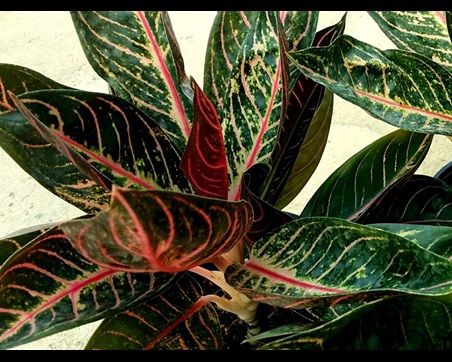
Looking quite unlike the green-leaved aglaonemas we are familiar with, Aglaonema ‘Pride of Sumatra’ is an early Indonesian hybrid by Mr Gregori Hambali that has beautiful red veins that contrast against a dark green background. It still has foliage features from one of its parents, Aglaonema rotundum.
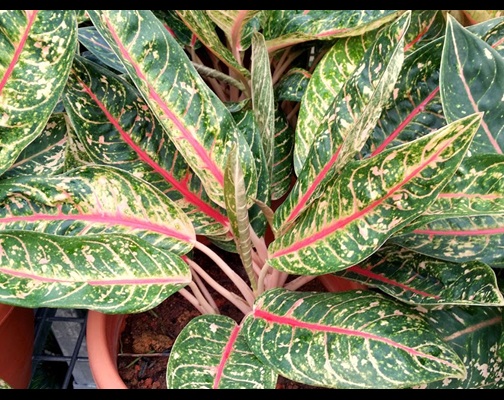
Another early hybrid created by Mr Gregori Hambali is Aglaonema ‘Donna Carmen. This hybrid is a robust and reliable plant that is still sold in local nurseries. It has more yellow in its leaves compared with Aglaonema ‘Pride of Sumatra’.
While earlier hybrids only had the red or pink colour on the veins or parts of the leaf blades, today, there are an increasing number of hybrids which have leaves that are entirely pink or red. These new Aglaonema hybrids make excellent festive plants for the Lunar New Year as their foliage colours are traditionally associated by the Chinese as lucky colours. Unlike many other Lunar New Year festive plants which are subtropical or temperate in origin, Aglaonema are tropical plants and when well-taken care of, can last well beyond the Lunar New Year.
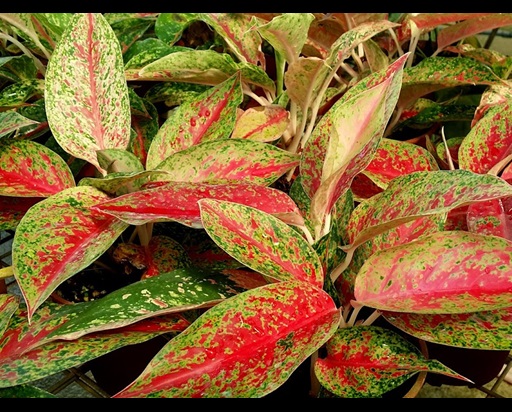
The many Thai Aglaonema hybrids sold in local nurseries look superficially alike and it is almost impossible to tell them apart and some even put a reliable cultivar name to them. Shown here is a hybrid with attractive leaves that have splashes of red that contrast beautifully with a golden yellow background. Several individuals of this cultivar make a nice display in a pot for Chinese New Year.
Read on to gather some tips on how to display them as well as how to grow them successfully.
Display
To display them for the festive season, purchase a few Aglaonema and plant them into a bowl-like pot that is wider than its depth. Depending on the foliage features, they are best displayed in simply designed pots that are either red or gold in colour, to go with the festive mood. The pot can be placed as a focal point on a coffee table or an end table next to a sofa in the living room.
Light Conditions
Aglaonema are best known for their shade tolerance. For the Lunar New Year, they can last indoors as a display in deep shade for the entire 15-day period. For long term growing, these plants can be situated on a windowsill or corridor area where they can receive filtered sunlight for several hours daily. They must not be exposed to direct sunlight as the intense light rays will scorch the leaves. These plants can also be grown under a desk lamp that is switched on during office hours.
Growing Media and Feeding
An important thing to note is that red and pink-leaved Aglaonema demand a light and aerated growing mix. A closer look at a nursery-bought plant will reveal that it is planted in a growing mix made up of coconut peat and coconut husk chunks. You should avoid planting it in a soil-based mix which is often too heavy and retains excessive moisture.
If you want to plant it outdoors in the garden, you may want to amend the soil by incorporating coconut husk chunks to make the soil structure more open. Note that not all cultivars will do well outdoors under exposed conditions.
Plants can be fed using slow-release fertiliser pellets like Osmocote that are put into the growing media. A dilute but regular application of a water-soluble fertiliser can also be used.
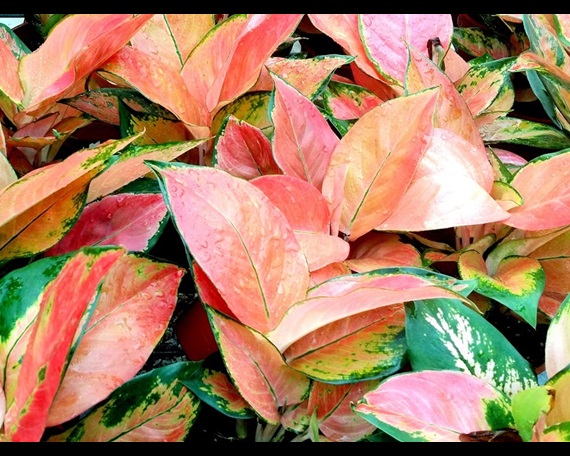
Shown here is another Thai Aglaonema hybrid with totally peach coloured leaves. These hybrids really change the way we look at the Chinese Evergreen as a foliage houseplant.
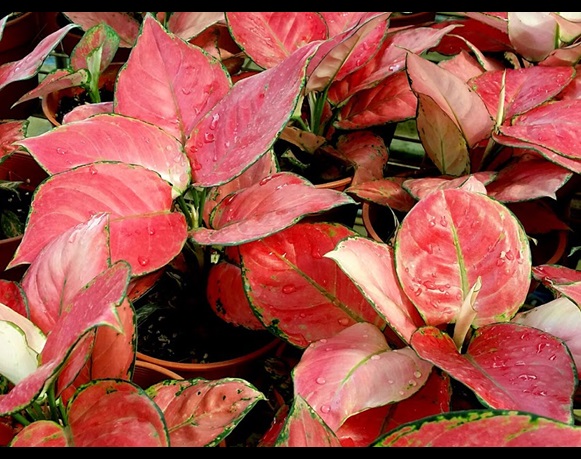
This is an Aglaonema hybrid with shocking pink leaves. A pot of this attractive plant with almost heart-shaped leaves makes a good display plant for the office desk. It will thrive under a desk lamp that is turned on during office hours. Water it once to twice weekly, and avoid keeping the growing media overly wet.
Watering and Air Circulation
The most common problem faced by growers of red and pink-leaved Aglaonema is basal rot of the stems and fungal/bacterial diseases of its leaves.
Whenever water is given, the growing media should just be moist to touch and not soggy. Plants can be allowed to dry out a little before the next watering. They should not be allowed to wilt. Plants that experienced prolonged wet feet due to over-zealous watering and/or heavy soil will often rot the base of the stems.
Leaves should also be kept dry. Avoid overhead watering as water trapped between the leaves can also lead to fungal/bacterial diseases. Grow plants under a protected location (roof overhead) with some air movement to help dry the leaves.
Text and photos by Dr Wilson Wong
Often considered as ‘old school plants’, earlier hybrids based on Aglaonema commutatum and Aglaonema nitidum created in the 1960s and 1970s, feature dark green, lance-shaped leaves that have silver markings. Due to their shade tolerance, these plants have become popular houseplants for indoor displays and shady corners in outdoor tropical-themed gardens.
In the 1980s, hybridisation efforts using Aglaonema rotundum in Thailand and Indonesia introduced a whole new range of colourful cultivars with attractive leaves that have red or pink colours in them.

Looking quite unlike the green-leaved aglaonemas we are familiar with, Aglaonema ‘Pride of Sumatra’ is an early Indonesian hybrid by Mr Gregori Hambali that has beautiful red veins that contrast against a dark green background. It still has foliage features from one of its parents, Aglaonema rotundum.

Another early hybrid created by Mr Gregori Hambali is Aglaonema ‘Donna Carmen. This hybrid is a robust and reliable plant that is still sold in local nurseries. It has more yellow in its leaves compared with Aglaonema ‘Pride of Sumatra’.
While earlier hybrids only had the red or pink colour on the veins or parts of the leaf blades, today, there are an increasing number of hybrids which have leaves that are entirely pink or red. These new Aglaonema hybrids make excellent festive plants for the Lunar New Year as their foliage colours are traditionally associated by the Chinese as lucky colours. Unlike many other Lunar New Year festive plants which are subtropical or temperate in origin, Aglaonema are tropical plants and when well-taken care of, can last well beyond the Lunar New Year.

The many Thai Aglaonema hybrids sold in local nurseries look superficially alike and it is almost impossible to tell them apart and some even put a reliable cultivar name to them. Shown here is a hybrid with attractive leaves that have splashes of red that contrast beautifully with a golden yellow background. Several individuals of this cultivar make a nice display in a pot for Chinese New Year.
Read on to gather some tips on how to display them as well as how to grow them successfully.
Display
To display them for the festive season, purchase a few Aglaonema and plant them into a bowl-like pot that is wider than its depth. Depending on the foliage features, they are best displayed in simply designed pots that are either red or gold in colour, to go with the festive mood. The pot can be placed as a focal point on a coffee table or an end table next to a sofa in the living room.
Light Conditions
Aglaonema are best known for their shade tolerance. For the Lunar New Year, they can last indoors as a display in deep shade for the entire 15-day period. For long term growing, these plants can be situated on a windowsill or corridor area where they can receive filtered sunlight for several hours daily. They must not be exposed to direct sunlight as the intense light rays will scorch the leaves. These plants can also be grown under a desk lamp that is switched on during office hours.
Growing Media and Feeding
An important thing to note is that red and pink-leaved Aglaonema demand a light and aerated growing mix. A closer look at a nursery-bought plant will reveal that it is planted in a growing mix made up of coconut peat and coconut husk chunks. You should avoid planting it in a soil-based mix which is often too heavy and retains excessive moisture.
If you want to plant it outdoors in the garden, you may want to amend the soil by incorporating coconut husk chunks to make the soil structure more open. Note that not all cultivars will do well outdoors under exposed conditions.
Plants can be fed using slow-release fertiliser pellets like Osmocote that are put into the growing media. A dilute but regular application of a water-soluble fertiliser can also be used.

Shown here is another Thai Aglaonema hybrid with totally peach coloured leaves. These hybrids really change the way we look at the Chinese Evergreen as a foliage houseplant.

This is an Aglaonema hybrid with shocking pink leaves. A pot of this attractive plant with almost heart-shaped leaves makes a good display plant for the office desk. It will thrive under a desk lamp that is turned on during office hours. Water it once to twice weekly, and avoid keeping the growing media overly wet.
Watering and Air Circulation
The most common problem faced by growers of red and pink-leaved Aglaonema is basal rot of the stems and fungal/bacterial diseases of its leaves.
Whenever water is given, the growing media should just be moist to touch and not soggy. Plants can be allowed to dry out a little before the next watering. They should not be allowed to wilt. Plants that experienced prolonged wet feet due to over-zealous watering and/or heavy soil will often rot the base of the stems.
Leaves should also be kept dry. Avoid overhead watering as water trapped between the leaves can also lead to fungal/bacterial diseases. Grow plants under a protected location (roof overhead) with some air movement to help dry the leaves.
Text and photos by Dr Wilson Wong





Have views or comments on this article? Let us know via this form. If you would like to give us feedback on any other areas relating to our parks and gardens, please submit via https://www.nparks.gov.sg/feedback